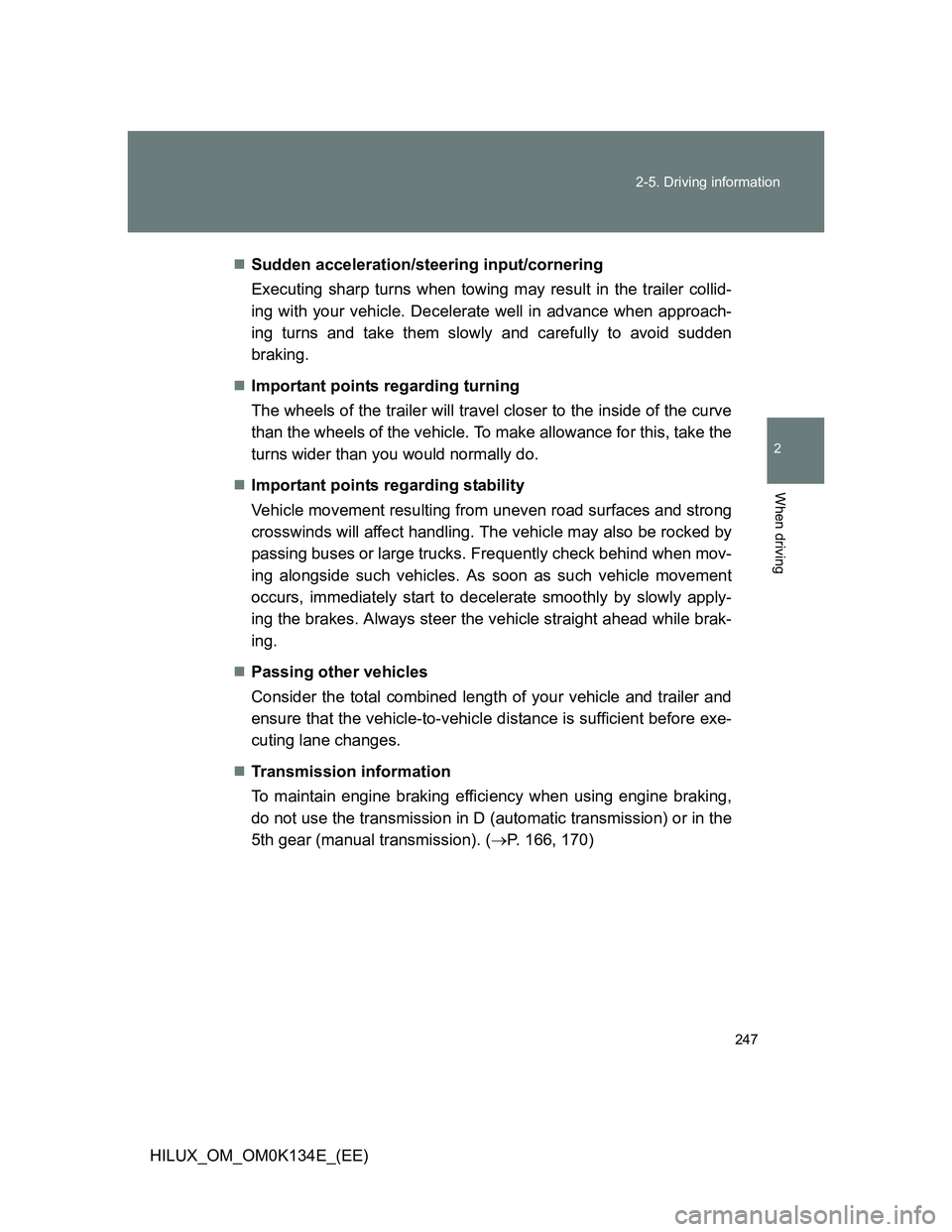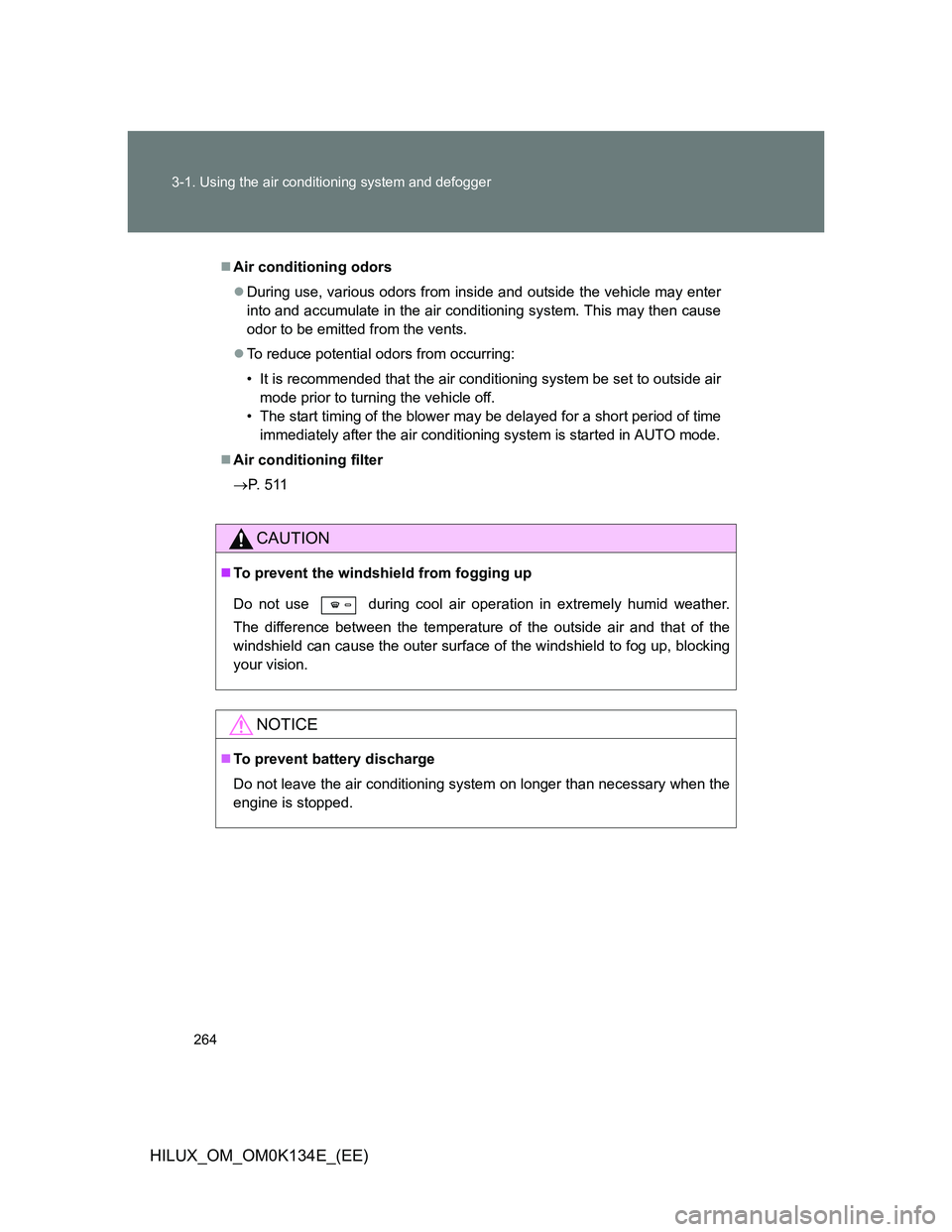Page 231 of 644
231 2-4. Using other driving systems
2
When driving
HILUX_OM_OM0K134E_(EE)
CAUTION
If the malfunction indicator light comes on
The malfunction indicator light comes on if you continue driving while the
DPF system warning light is flashing. In this event, damage may be caused
to the vehicle or an accident may occur. Have the vehicle inspected by any
authorized Toyota dealer or repairer, or another duly qualified and equipped
professional, immediately.
NOTICE
To prevent the DPF system from failing
Do not drive for long periods of time while the DPF system warning light is
flashing
Do not use fuel other than the specified type
Do not use engine oil other than the recommended type
Do not modify the exhaust pipe
Page 235 of 644
235
2-5. Driving information
2
When driving
HILUX_OM_OM0K134E_(EE)
Winter driving tips
Carry out the necessary preparations and inspections before driving
the vehicle in winter. Always drive the vehicle in a manner appropri-
ate to the prevailing weather conditions.
Pre-winter preparations
Use fluids that are appropriate to the prevailing outside tem-
peratures.
• Engine oil
• Engine coolant
• Washer fluid
Have a service technician inspect the level and specific grav-
ity of battery electrolyte.
Have the vehicle fitted with four snow tires or purchase a set
of tire chains for the rear tires.
Ensure that all tires are the same size and brand, and that chains
match the size of the tires.
Page 241 of 644
241 2-5. Driving information
2
When driving
HILUX_OM_OM0K134E_(EE)Information tag (manufacturer’s label)
Ty p e A
Gross vehicle mass
Maximum permissible rear
axle capacity
Ty p e B
Gross vehicle mass
The combined weight of the driver, passengers, cargo, towing
hitch, total curb mass and drawbar load must not exceed the gross
vehicle mass. Exceeding this weight is dangerous.
Maximum permissible rear axle capacity
The weight borne by the rear axle should not exceed the maximum
permissible axle capacity. Exceeding this weight is dangerous.
The values for towing capacity were derived from testing conducted at sea
level. Take note that engine output and towing capacity will be reduced at
high altitudes.
Page 247 of 644

247 2-5. Driving information
2
When driving
HILUX_OM_OM0K134E_(EE)Sudden acceleration/steering input/cornering
Executing sharp turns when towing may result in the trailer collid-
ing with your vehicle. Decelerate well in advance when approach-
ing turns and take them slowly and carefully to avoid sudden
braking.
Important points regarding turning
The wheels of the trailer will travel closer to the inside of the curve
than the wheels of the vehicle. To make allowance for this, take the
turns wider than you would normally do.
Important points regarding stability
Vehicle movement resulting from uneven road surfaces and strong
crosswinds will affect handling. The vehicle may also be rocked by
passing buses or large trucks. Frequently check behind when mov-
ing alongside such vehicles. As soon as such vehicle movement
occurs, immediately start to decelerate smoothly by slowly apply-
ing the brakes. Always steer the vehicle straight ahead while brak-
ing.
Passing other vehicles
Consider the total combined length of your vehicle and trailer and
ensure that the vehicle-to-vehicle distance is sufficient before exe-
cuting lane changes.
Transmission information
To maintain engine braking efficiency when using engine braking,
do not use the transmission in D (automatic transmission) or in the
5th gear (manual transmission). (P. 166, 170)
Page 248 of 644

248 2-5. Driving information
HILUX_OM_OM0K134E_(EE)If the engine overheats
Towing a loaded trailer up a long, steep incline in temperatures
exceeding 30C (85F) may result in the engine overheating. If the
engine coolant temperature gauge indicates that the engine is
overheating, turn the air conditioning off immediately, leave the
road and stop the vehicle in a safe place. (P. 592)
When parking the vehicle
Always place wheel chocks under the wheels of both the vehicle
and trailer. Firmly set the parking brake and shift the shift lever to P
for automatic transmissions, and 1 or R for manual transmissions.
CAUTION
Follow all the precautions described in this section. Failure to do so could
cause an accident resulting in death or serious injury.
Trailer towing precautions
When towing, make sure that none of the weight limits are exceeded.
(P. 240)
Vehicle speed in towing
Observe the legal maximum speeds for trailer towing.
Before descending hills or long declines
Reduce speed and downshift. However, never downshift suddenly while
descending steep or long down hill grades.
Operation of the brake pedal
Do not hold the brake pedal depressed often or for long periods of time.
Doing so may result in the brake overheating or reduce braking effects.
Page 249 of 644
249 2-5. Driving information
2
When driving
HILUX_OM_OM0K134E_(EE)
CAUTION
To avoid accident or injury
The gross combination mass (sum of your vehicle mass plus its load and the
total trailer mass) must not exceed the following:
Single-cab models
5140 kg (11332 lb.)
Extra-cab models
5120 kg (11288 lb.): 4WD models
5090 kg (11222 lb.): Pre Runner
Double-cab models
5220 kg (11508 lb.): 1KD-FTV engine for Norway
5230 kg (11530 lb.): 1KD-FTV engine except for Norway
5180 kg (11420 lb.): 2KD-FTV engine, 4WD models for Norway
5190 kg (11442 lb.): 2KD-FTV engine, 4WD models except for Norway
5100 kg (11244 lb.): 2KD-FTV engine, Pre Runner
Page 257 of 644
257 3-1. Using the air conditioning system and defogger
3
Interior features
HILUX_OM_OM0K134E_(EE)
CAUTION
To prevent the windshield from fogging up
Do not use during cool air operation in extremely humid weather.
The difference between the temperature of the outside air and that of the
windshield can cause the outer surface of the windshield to fog up, blocking
your vision.
NOTICE
To prevent battery discharge
Do not leave the air conditioning system on longer than necessary when the
engine is stopped.
Page 264 of 644

264 3-1. Using the air conditioning system and defogger
HILUX_OM_OM0K134E_(EE)
Air conditioning odors
During use, various odors from inside and outside the vehicle may enter
into and accumulate in the air conditioning system. This may then cause
odor to be emitted from the vents.
To reduce potential odors from occurring:
• It is recommended that the air conditioning system be set to outside air
mode prior to turning the vehicle off.
• The start timing of the blower may be delayed for a short period of time
immediately after the air conditioning system is started in AUTO mode.
Air conditioning filter
P. 5 1 1
CAUTION
To prevent the windshield from fogging up
Do not use during cool air operation in extremely humid weather.
The difference between the temperature of the outside air and that of the
windshield can cause the outer surface of the windshield to fog up, blocking
your vision.
NOTICE
To prevent battery discharge
Do not leave the air conditioning system on longer than necessary when the
engine is stopped.